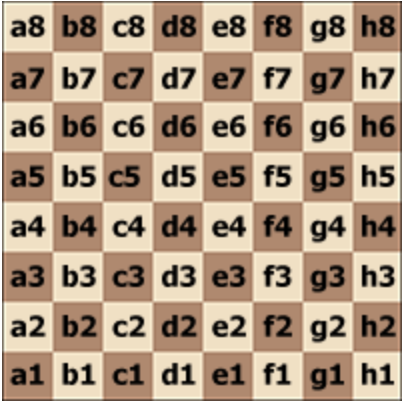The Universal Language of Chess
Algebraic notation is the standard system recognized worldwide for recording chess moves.
It is the only notation officially recognized by FIDE for tournaments and matches, and most chess books and educational materials also adopt this format. Please refer to the link below for detailed specifications.
Appendix C. Algebraic Notation – FIDE Rules Commission
This article summarizes only the basic aspects.
Coordinate System
In algebraic notation, every square on the chessboard has a unique coordinate:
- Files (columns): Labeled a-h from left to right.
- Ranks (rows): Numbered 1-8 from bottom to top (from White's perspective).

Basic Notation Rules
Piece Symbols
These symbols refer to all pieces except pawns.
- King: K
- Queen: Q
- Rook: R
- Bishop: B
- Knight: N (to avoid confusion with King)
Move Notation
Basic moves are written as: [Piece][Destination Square]
Common Move Examples
Pawn Moves
For pawns, only the destination square is written. It is not necessary to add 'P' for pawn, like Pe4.
- e4: Pawn moves to e4
- d5: Pawn moves to d5
- a7: Pawn moves to a7
Piece Moves
For pieces, their corresponding symbol is used as a prefix.
- Nf3: Knight moves to f3
- Bc4: Bishop moves to c4
- Qd2: Queen moves to d2
- Kf1: King moves to f1
- Ra1: Rook moves to a1
Captures
When a piece captures another, x is used.
- exd5: Pawn on the e-file captures on d5
- Nxe4: Knight captures on e4
- Bxh7: Bishop captures on h7
- Qxd8: Queen captures on d8
Disambiguation
When multiple pieces of the same type can move to the same square, it is necessary to specify which piece is moving.
Disambiguation by File
- Nbd2: Knight on the b-file moves to d2
- Rdf1: Rook on the d-file moves to f1
Disambiguation by Rank
- R1a3: Rook on the 1st rank moves to a3
- N1f3: Knight on the 1st rank moves to f3
Special Moves
Castling
- O-O: Kingside castling (short castling)
- O-O-O: Queenside castling (long castling)
En Passant
- exd6 e.p.: Pawn captures en passant on d6
- However, the en passant symbol ("e.p.") can be omitted.
Pawn Promotion
- e8=Q: Pawn promotes to Queen on e8
- a1=N: Pawn promotes to Knight on a1
Checks and Checkmates
Check
Add + after the move.
- Qh5+: Queen moves to h5, checking
- Bc4+: Bishop moves to c4, checking
Checkmate
Add # after the move.
- Qh7#: Queen moves to h7, checkmating
- Rd8#: Rook moves to d8, checkmating
Common Symbols
Move Quality
- !: Good move
- !!: Brilliant move
- ?: Dubious move
- ??: Blunder
- !?: Interesting move
- ?!: Questionable move
Position Evaluation Symbols
- =: Equal position
- ±: White has a slight advantage
- ∓: Black has a slight advantage
- +-: White has a decisive advantage
- -+: Black has a decisive advantage
Sample Game Notation
1. e4 e5
2. Nf3 Nc6
3. Bc4 Bc5
4. O-O d6
5. d3 f5
6. exf5 Bxf5
7. Ng5 Nh6
8. Qh5+ g6
9. Qxc5 dxc5
10. Bxh6
Common Mistakes to Avoid
- Forgetting piece symbols: Write Nf3, not nf3.
- Insufficient disambiguation: Forgetting to specify which piece when multiple can move to the same square.
- Forgetting check symbols: Always add + for a check.